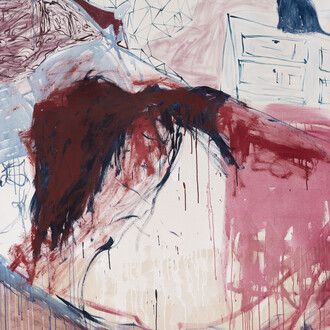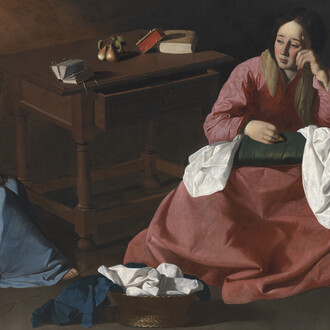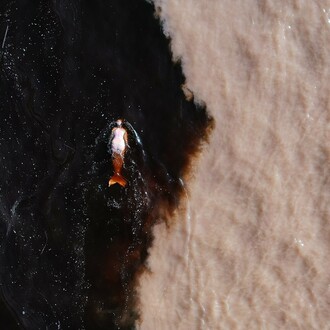‘…The souvenir displaces the point of authenticity as it itself becomes the point of origin for narrative. Such a narrative cannot be generalised to encompass the experience of anyone…it is a narrative that seeks to reconcile the disparity between interiority and exteriority, subject and object, signified and signifier’… - From ‘On Longing, narratives of the miniature, the Gigantic, the souvenir, the Collection’ – Susan Stewart, Duke University Press, 1993 ed.
The forging of narrative fragments with materiality and a sense of mise-en-scene is in force in the work of Clare Kenny. In using disparate matter such as discarded kitchenware, paint, plaster and her own salvaged photographs, a sense of the familiar is something that always catches the corner of your eye.
Living in Basel, Switzerland, but originating from Manchester, England there persists a tension in Kenny’s work between that which is constructed from memory, and a certain sense of historicity of material matter – and yet not. Kenny would say that her work is a construction of fact versus fiction, memory versus illusion, immaterial-ness and materiality. What seems pertinent is that her approach to materials is a notably contemporary one. For example, marble is flattened and malleable, photographs are curled, rolled, folded and hole-punched, utility objects made hard and non-useable.
As well as the playfulness in what this may suggest, there is an arc in Kenny’s work that melds feminine and masculine sensibilities. In this way one could argue that Kenny de-genderises materials rendering their historical associations, indistinct and in a way non-traceable, messed up but intrinsically ‘present’.
The components within Clare Kenny’s first solo show at London’s Vitrine read a bit like a deconstructed house, with a confounding sense of interior and exterior features. The artist’s father was a builder and she has grown up around the activity of continuous transformations of materials into structure. Rather than standing abruptly as contestation and conversation with sculptural traditions, Kenny’s work actively plays with our sense of understanding things in the world both in and outside of artistic reality.
The plaster works, entitled, ‘Old English’ (a title that Kenny gleaned from an online catalogue of Chinese fake cladding), seem to embody an intrinsic understanding of petty value hierarchies. Sporadically dispersed throughout the gallery space, Kenny has woven threads of different colour into the plasterworks, that seem to hold these values in place whilst, simultaneously mocking them with the starkness of the white, white plaster and artificial, ‘neon’ like colour. The reference in the title also exposes the surface of the work as shifting and gestural, a bit like Kenny’s freckled childhood memory of such things.
“There is a sense of allure in my work. I wanted to assemble an exhibition that assesses and re-constructs my memories of places where I have lived, and aspects of my upbringing at the same time….But also acknowledge the fact that memory is never completely accurate. I wanted to fill these gaps, be suggestive with them, and play with the ‘landscape’ of the work in a gallery context”.
I also questioned Kenny about a photographic work, ‘Meteorite’ that stems from a memory of a rock falling to earth near her home in Manchester; “I’m not entirely sure this actually happened to me as my own experience, or whether it is something that I heard about at the time. For me, the point was to recollect the event of me knowing this at that time and knowing that such events occur in nature. With this piece I wanted to make something real and not real at the same time…the photograph has silver in the paper and that is something that is contained in meteors, the photograph presents the reality of the event. The fact that then this is made to look like a rock, by me screwing up the photograph into a ball, is in a sense, the element that makes the work complete, in its ambiguity.”
I suggest to Kenny that Susan Stewart’s citing of Kenneth Burke’s assertion that, “there are no forms of art which are not forms of experience outside of art”, may be a pertinent one, particularly in this exhibition, “yes, definitely – memories operate in elusive ways…they are often collective experiences, that over time are assimilated as personal experience, and this is something I have been looking at and thinking about for some time.”
Also in the show at Vitrine are series of works that are made to look like trellises commonly found in gardens and back yards. Kenny has fabricated the trellises in metal and interlaced them with various materials, from a neon ‘rope’ to photographs whose surfaces have in a sense been defaced: “ I wanted to use a symbol from suburbia, and of a certain type of living and use it in a way that makes it non-functioning and in a way meaningless, reduce it to surface elements that use the language of art and in particular, here, sculpture. To ‘impotise’ it a way….. I feel wary of certain upheld values and the trellis object seems to symbolise something that is pretty far away from my life as an adult, but something which has a language that I understand, and feel close to, somehow.”
Kenny constantly refers to the magnetism of the ‘authentic’ and how we are seduced by an understanding of heightening value when this is conveyed through history, with claims of legitimacy and vintage. Within this show - and Clare Kenny’s work on the whole - these values are contested, challenged and in a way, undermined.
The narrative that she weaves into the work draws from a rich source of materials, fact, fiction and form.
Text by Natasha Rees



















